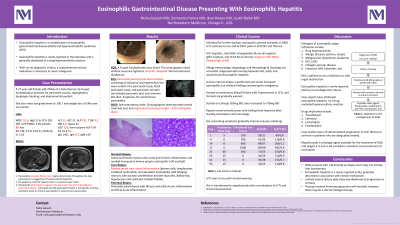Monday Poster Session
Category: Liver
P2527 - Eosinophilic Gastrointestinal Disease Presenting With Eosinophilic Hepatitis
Monday, October 23, 2023
10:30 AM - 4:15 PM PT
Location: Exhibit Hall

Has Audio

Nisha Ganesh, MD
Northwestern Medicine
Chicago, IL
Presenting Author(s)
Nisha Ganesh, MD, Justin Boike, MD
Northwestern Medicine, Chicago, IL
Introduction: Eosinophilic hepatitis is a manifestation of eosinophilic gastrointestinal disease (EGID)/hypereosinophilic syndrome (HES) that is rarely reported in the literature and generally attributed to a drug-mediated hypersensitivity reaction. With no set diagnostic criteria, a comprehensive clinical evaluation is necessary to reach a diagnosis. Here we present a case of eosinophilic hepatitis with no known trigger.
Case Description/Methods: A 77-year-old woman with a history of a hiatal hernia with Toupet fundoplication presents to clinic for increased frequency of regurgitation, dysphagia, bloating, and abdominal discomfort. She also notes low grade fevers and weight loss. Laboratory assessment is notable for WBC 10.6 with 8% eosinophils, ALT 52, AST 31, ALP 792, Tbili 3.3, and negative infectious hepatitides. EGD with EUS reveales gastric erythema and pancreatic parenchymal abnormalities. ERCP cholangiogram demonstrates segmental stricturing of intrahepatic ducts. Gastric biopsy is notable for acute and chronic inflammation with greater than 50 eosinophils/HPF, and liver biopsy shows marked portal tract mixed inflammatory infiltrate, including lymphocytes, plasma cells, and abundant eosinophils. Additional labs demonstrate atypical 1:320 ANCA, elevated IgE at 460 kU/L, and ASMA 1:40. Peripheral eosinophilia peaks at 1.8 K/UL. A bone marrow biopsy shows increased eosinophils, but without findings concerning for malignancy. She is started on prednisone, mycophenolate, and budesonide, and is later transitioned to mepolizumab and budesonide alone with normalization of her liver chemistries and clinical resolution of her symptoms.
Discussion: This case represents a likely overlap between atypical autoimmune hepatitis and hepatic involvement of EGID with additional gastric, pancreatic, and biliary involvement. Eosinophilic hepatitis is a rarely described entity that is generally identified in association with certain medications or with eosinophilic infiltration of the ampulla. Although research on the natural history of eosinophilic hepatitis has been limited, case studies have not demonstrated progression to liver fibrosis or cirrhosis in patients who are adequately treated. Management of these patients involves immunosuppression with systemic steroids, although there may also be a role for biologics such as anti-IL-5 agents. Eosinophilic hepatitis is an uncommon diagnosis yet should remain on the differential for patients with evidence of hepatitis and other hypereosinophilic syndromes.
Disclosures:
Nisha Ganesh, MD, Justin Boike, MD. P2527 - Eosinophilic Gastrointestinal Disease Presenting With Eosinophilic Hepatitis, ACG 2023 Annual Scientific Meeting Abstracts. Vancouver, BC, Canada: American College of Gastroenterology.
Northwestern Medicine, Chicago, IL
Introduction: Eosinophilic hepatitis is a manifestation of eosinophilic gastrointestinal disease (EGID)/hypereosinophilic syndrome (HES) that is rarely reported in the literature and generally attributed to a drug-mediated hypersensitivity reaction. With no set diagnostic criteria, a comprehensive clinical evaluation is necessary to reach a diagnosis. Here we present a case of eosinophilic hepatitis with no known trigger.
Case Description/Methods: A 77-year-old woman with a history of a hiatal hernia with Toupet fundoplication presents to clinic for increased frequency of regurgitation, dysphagia, bloating, and abdominal discomfort. She also notes low grade fevers and weight loss. Laboratory assessment is notable for WBC 10.6 with 8% eosinophils, ALT 52, AST 31, ALP 792, Tbili 3.3, and negative infectious hepatitides. EGD with EUS reveales gastric erythema and pancreatic parenchymal abnormalities. ERCP cholangiogram demonstrates segmental stricturing of intrahepatic ducts. Gastric biopsy is notable for acute and chronic inflammation with greater than 50 eosinophils/HPF, and liver biopsy shows marked portal tract mixed inflammatory infiltrate, including lymphocytes, plasma cells, and abundant eosinophils. Additional labs demonstrate atypical 1:320 ANCA, elevated IgE at 460 kU/L, and ASMA 1:40. Peripheral eosinophilia peaks at 1.8 K/UL. A bone marrow biopsy shows increased eosinophils, but without findings concerning for malignancy. She is started on prednisone, mycophenolate, and budesonide, and is later transitioned to mepolizumab and budesonide alone with normalization of her liver chemistries and clinical resolution of her symptoms.
Discussion: This case represents a likely overlap between atypical autoimmune hepatitis and hepatic involvement of EGID with additional gastric, pancreatic, and biliary involvement. Eosinophilic hepatitis is a rarely described entity that is generally identified in association with certain medications or with eosinophilic infiltration of the ampulla. Although research on the natural history of eosinophilic hepatitis has been limited, case studies have not demonstrated progression to liver fibrosis or cirrhosis in patients who are adequately treated. Management of these patients involves immunosuppression with systemic steroids, although there may also be a role for biologics such as anti-IL-5 agents. Eosinophilic hepatitis is an uncommon diagnosis yet should remain on the differential for patients with evidence of hepatitis and other hypereosinophilic syndromes.
Disclosures:
Nisha Ganesh indicated no relevant financial relationships.
Justin Boike: Fujifilm Holdings Corporation – Consultant. W.L. Gore & Associates, Inc. – Consultant.
Nisha Ganesh, MD, Justin Boike, MD. P2527 - Eosinophilic Gastrointestinal Disease Presenting With Eosinophilic Hepatitis, ACG 2023 Annual Scientific Meeting Abstracts. Vancouver, BC, Canada: American College of Gastroenterology.
